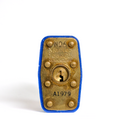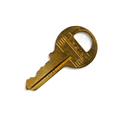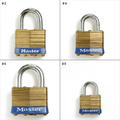Master Lock No 6: Difference between revisions
(Created page with "<span style="font-size: 188%; line-height:190%">{{PAGENAME}}</span> ---- {{Lock model | name = Master Lock No. 6 | Img = File:Master Lock No 6 front - FXE48762.png | Img_size = 150px | maker = Master Lock | lock_type = Padlock, Cylinder | lock_design = Pin-tumbler | years_produced = | patent = | related = | spec_on = true | spec_comptype = Pin-tumbler | spec_comp = 4 }} The '''No. 6''' is a pin-tumbler padlock made...") |
mNo edit summary |
||
| Line 5: | Line 5: | ||
| name = Master Lock No. 6 | | name = Master Lock No. 6 | ||
| Img = File:Master Lock No 6 front - FXE48762.png | | Img = File:Master Lock No 6 front - FXE48762.png | ||
| Img_size = | | Img_size = 200px | ||
| maker = [[Master Lock]] | | maker = [[Master Lock]] | ||
| lock_type = [[Padlock]], [[Cylinder]] | | lock_type = [[Padlock]], [[Cylinder]] | ||
Revision as of 14:08, 28 April 2023
Master Lock No 6
| Master Lock No. 6 | |
 | |
| Name | Master Lock No. 6 |
|---|---|
| Manufacturer | Master Lock |
| Lock Type | Padlock, Cylinder |
| Lock Design | Pin-tumbler |
| Specifications | |
| # of Components | 4 |
| Component Type | Pin-tumbler |
The No. 6 is a pin-tumbler padlock made by Master Lock. The No. 6 uses a laminated brass padlock body with an internal key-in-knob-style cylinder. The inner cylinder uses four pin stacks and does not use any security pins.
The No. 6 is a common low security padlock used in the United States. It is one of a line of laminated brass padlocks that includes the Master Lock #2, #4, #6, and #8.
Principles of operation
The No. 6 cylinder is a pin-tumbler lock with four pin stacks and no security pins. The cylinder typically uses the M1 key profile but may use other profiles, as well. The standard No. 6 can be opened in both directions but the "commercial" series body restricts opening to clockwise rotation. The No. 6 is not a key retaining padlock.
Disassembly instructions
The No. 6 cannot be disassembled non-destructively. To disassemble it the rivets that hold the laminated body together must be removed and each layer removed individually. The inner cylinder itself can be disassembled in the same manner as a traditional pin-tumbler lock:
- Remove the cam or C-clip.
- Insert the key and turn the plug 45-90 degrees.
- Withdraw the plug from the cylinder. (A plug follower is recommended)
OR
- Remove the chamber casings and take out each pin-stack individually
- Remove the cam or C-clip.
- Withdraw the plug from the cylinder.
Notes
- The cylinder requires a small diameter plug follower.
- The plug is retained by a crimp, rather than a C-clip or cam. Above are the generic pin-tumbler disassembly instructions.
Vulnerabilities
The No. 6 is vulnerable to a wide range of attacks. The reduced pin tumbler count and poor manufacturing tolerances makes it an easy lock to pick. It's commonly given to locksport beginners as a "confidence lock"; a lock that is easy to open and inspires you to continue picking. The No. 2 may be vulnerable to one or more of the following:



